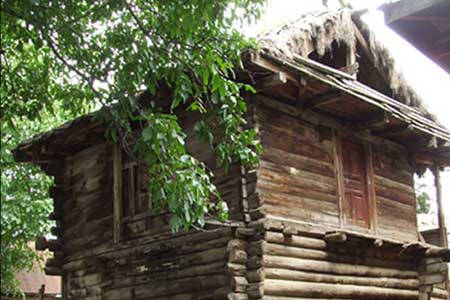Lolab, literally the waters of love, is one of the most beautiful places in Kashmir inhabited by beautiful, hardworking people mired in tradition and living in traditional houses. Hamidullah Dar reports

The hardworking people inhibiting the small Lolab Valley in north Kashmir have a unique life style. The beautiful women and men, for centuries have been living off the land and the forests surrounding them. Even after much progress and transformation of its economy, most of them still live in the traditional wood and mud houses, architecture of which, to some may seem primitive, has evolved over centuries.
Their dependence on the forests from grazing cattle to almost everything else can be gauged by seeing the myriad use wood is put to in the area. Most of the household articles and kitchenware is made of wood. And so are the houses.
Lapped in the mountains covered with cedar trees, around 30 percent of the fertile Lolab valley’s houses are exclusively made of timber and mud with tin sheets roof. Even in the times when brick, mortar and iron are the staple construction material, many people in Lolab still prefer wood and mud for constructing homes.
Living very close to, or within, forests gives the people easy access to timber, which they collect themselves without any permission or payment.
Farmer Ghulam Mohiudin Mir of Potshai village who cultivates maize over his five-kanal land is constructing a house using timber and mud only. “We are a poor and cannot afford cement and brick for building a house. We bring wood, mostly from dried and fallen trees to construct our houses,” said Mir.
Around 90 percent of the 500 houses in this village are wood and mud houses. Nazir Ahmad Mir is a carpenter and the village head. Nazir says, “It takes two carpenters and a few helpers one month to complete a house,” said Mir.
The forests mostly grow cedar trees and its wood is the most preferred in constructions as it has higher longevity and toughness. But the growth of population and demand for houses has put the forests under pressure.
Karimudin Khatana of Khodi village claims that most of the tress in the woods near the village are young, mostly 50 year old. All the houses in khodi village are made of wood and mud only.“It is a tough and far off terrain so we cannot afford building material other than wood. Besides, a habit of centuries of living in such homes discourages use of other building materials,” says Khatana. The mountainous slopes around the village, however, are bereft of any tress as that might have been consumed in building houses for the ever growing population.
“Nobody plants a tree even after he fells dozens for constructing just one house. These (cedar trees) grow themselves after some time and that is why you find so many trees even after indiscriminate felling,” says Ghulam Mohammad Khan, a school teacher from Dooniwara.

On an average it takes around 1200 cubic feet of wood to build such a house, says carpenter Nazir. Besides residential houses wood is used for building cow sheds, granaries, hen houses, fencing courtyards or maize fields. The extensive use of timber has depleted vast stretches of green forests and left barren patches on a verdant surface.
Locals claim that they don’t cut green tress and use only dry wood and timber of the tress that have fallen on their own, for constructing homes. But Nazir Mir says, “People here do cut green trees.”
Logs of wood logs are cut into long clefts of four inches with and 12 inches breadth. These clefts are placed horizontally one over other and fastened with iron nails. First four sides of the house are erected and a tin sheets roof is laid over it. Then rooms, windows and doors are settled in it and finally the floor is laid. Then crevices are filled up with mud to keep cold away.
The houses are highly fire prone and are built at a distance from one another. “There is always danger of a fire incident in such houses, so they are built with a safe distance in between. Also the kitchen and particularly the hearth area is protected from catching fire by profuse usage of mud,” says Riyaz Ahmad, a government employee.
The dwindling of forest cover and a raised awareness to protect the forests is making many Lolab residents mull other options for constructing their houses. But most of the locals can’t afford brick and cement.
“If government is really interested in saving the forests, it has to keep the building material available in the area at a subsidised price. It will create affordability that will convince people to opt for houses made of other materials than wood,” says Khan.
Most of the residents of the area allege that forest department employees are seldom seen in the area which leaves forests at the mercy of looters. “Forest department is seen as a compliant agent in the loot here. Hardly any person gets caught and punished for smuggling timber. It is really bad”, complains Rasik Ahmad Magray, a college student from Wavoora while casting a dismal look on the forests nearby.















